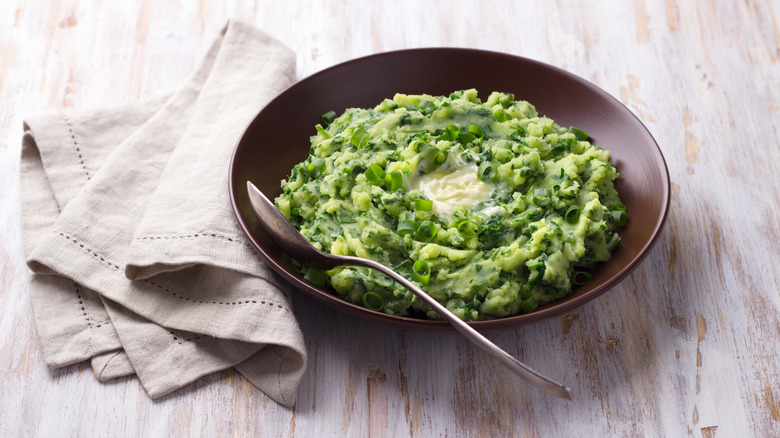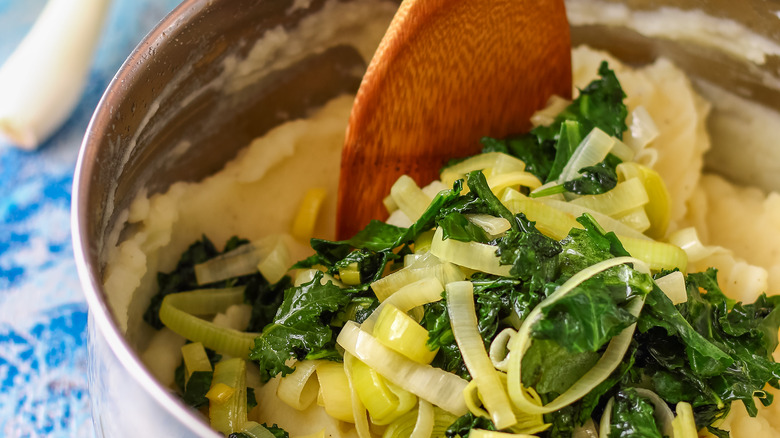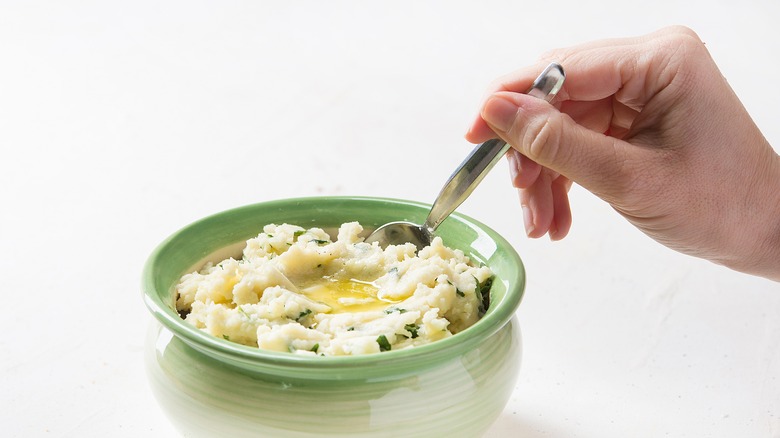Colcannon: The Traditional Irish Side That's Perfect For St. Patrick's Day
St. Patrick's Day is more than just a good excuse to pinch people. Honoring the death of Ireland's patron saint, a prolific missionary legendarily said to have rid the Emerald Isle of snakes, the holiday is a significant mark of the impact Irish immigrants have had around the world, particularly in the United States.
A number of our St. Patrick's Day traditions are oddly backward, however, such as wearing the color green. The earliest paintings of St. Patrick show him dressed in blue, a color associated with Flaitheas Éireann, a mythical figure representing Irish sovereignty. Green rose to prominence much later as a color associated with Ireland's rebellion against Britain.
Another St. Patrick's Day symbol that's out of touch with history is the potato, foundational to so many popular Irish dishes. In an ironic twist, St. Patrick never ate potatoes, which are native to the Andes mountains and weren't introduced to Ireland until the 17th century. St. Patrick lived in the 5th century, a time when Irish cuisine was dominated by dairy.
However, when potatoes finally made it to Ireland, they became the principal food source for much of the island's population, so even if it doesn't fit with St. Patrick's timeline, it's a fitting ingredient to honor Irish heritage. We suppose if you were really serious about celebrating St. Patrick himself, you could drink a whole lot of milk, but it would probably be more pleasant to make a pot of colcannon.
What is colcannon?
Colcannon is essentially mashed potatoes taken up a level. Kale or cabbage gets mixed into the mash along with some combination of scallions, leeks, chives, and onions. Some recipes even call for bacon. There's typically a hefty dose of butter thrown in there, so we suppose it does honor the dairy-rich diet of St. Patrick's Ireland. Plus, since kale and cabbage were both staples of the Irish diet long before potatoes came to the island, it's very possible that ancient Irish cooks made a similar dish sans spuds.
The name derives from an old Gaelic term, cal ceannann, which means 'white-headed cabbage,' and became a staple of working-class Irish homes in the 17th and 18th centuries. It ultimately earned a prominent position in Irish culture, even forming the basis of an old folk song called "The Skillet Pot" (alternatively "The Auld Skillet Pot"), which includes lyrics like: "Did you ever eat colcannon, made from lovely pickled cream? With the greens and scallions mingled like a picture in a dream."
Can colcannon predict your future?
Though it's become a popular St. Patrick's Day side dish in the U.S., colcannon is associated with a much different holiday in Ireland: Halloween.
On that chilly autumn night, people play fortune-telling games wherein they hide symbolic trinkets in plates of colcannon, not unlike the baby in a king cake. If a young diner found a ring in their mash, it was a sign that they would soon be married. If a man found a button in his plate, or a woman found a thimble, it meant they were doomed to stay single.
Finding coins in your colcannon meant that wealth lay in your future, while finding a rag foreshadowed a life of poverty. The grimmest symbol of all was a small stick, which meant that the diner's spouse was going to beat them. Our recipe for colcannon is quite simple, but we suggest omitting any sticks.


